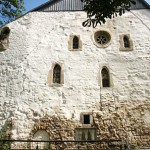Catchy title, innit? I can’t claim credit, though. It’s the name of an exhibit of medieval jewelry at the Wallace Collection in London.
The 14th century jewels come from two hoards — one uncovered in Colmar, France, in 1863, the other in Erfurt, Germany, in 1998 — most likely buried by Jews in fear of their lives during the Black Death when gentiles blamed them for causing the plague.
The entire Jewish population of Colmar was massacred in January 1349, and 1000 Erfurt Jews were slaughtered in one day in March 1349, so probably whoever buried their most precious treasures never had a chance to retrieve them because they were killed during these pogroms, died of plague or were expelled never to return.
Most of the surviving gold and silver treasures from this time are ecclesiastical, since secular gold and silverwork tended to be remade later into more fashionable jewellery or melted down for coinage. But here we can see what fashionable men and women about town were wearing 650 years ago: lumpily gaudy brooches with tiny heraldic lions roaring among boulders of sapphire and garnet; belt fittings with robed figures and serpentine beasts in gothic niches; silver-gilt clasps in the form of fleurs-de-lis, dragons and flowers.
There is also a handy cosmetic set that would have hung from a belt, comprising a little silver flask that may have contained scent, a tiny scoop for ear-cleaning, and attachments for other beauty tools. Some of the symbols could do sentimental service on charm bracelets today: clasping hands, a padlock, a bow poised to shoot love’s arrow.
Many of the objects relate to marriage. The star exhibit, from Erfurt, is a gold Jewish wedding ring (pictured [left]), shaped like a hexagonal building – symbolising both the marital home and the Temple of Jerusalem – with gothic arches, gables and a pyramidal roof on which is inscribed mazel tov (good wishes). The same slogan adorns two similar rings, from Colmar and from a hoard found in Weissenfels, Germany. These large and precious pieces were worn only on the day of the wedding ceremony.
The exhibition runs until May 10th and admission is free.
 Once the Erfurt hoard returns to Germany it will go permanently on display in what was once the Erfurt synagogue.
Once the Erfurt hoard returns to Germany it will go permanently on display in what was once the Erfurt synagogue.
Built around 1100 A.D., the Old Synagogue is thought to be the oldest standing synagogue in Europe. Many parts of the building are original, including, notable for its rarity, the roof.
It was used as a warehouse after the 1349 massacre until it became a dance hall in the late 19th c. Nazis partied the night away there, unaware of its history.
The jewelry is truly a snapshot in time because so much gold just got recycled over the years. I think I’ve heard a statistic along the lines of 90+ % of the gold around today is recycled from older gold and forms. There are sure to be more caches like this waiting to be found. Jews were persecuted all over Europe during the plagues.
I’m sure there are many caches still cached. Of course, we don’t know about all the ones that have been found because they might have been sold off on the sly.
The Colmar hoard is reputed to have been considerably larger, but the finders didn’t cough it all up. There’s no evidence so nobody knows exactly what was found and where it all is.
This post chills my blood–the Black Death, entire Jewish populations being killed in a day, their unknown hoards all across Europe …
Hans’ comment about the recycling is very interesting.
I didn’t know about the Erfurt synagogue. It is beautiful.
It is horrifying to think about the victims of these mass-murders, especially with artifacts like these which testify to their most special moments. 🙁